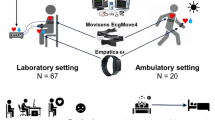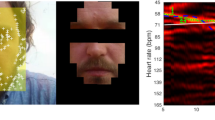Abstract
The exponential increase of wearable health-tracking technologies offers new possibilities but also poses new challenges in signal processing to enable fitness monitoring through multimodal physiological recordings. Although there are several software tools used for post-processing in physiological computing applications, limitations in the analysis, incorporating signals from multiple sources, integrating contextual information and providing information visualization tools prevent a widespread use of this technology. To address these issues, we introduce PhysioLab, a multimodal processing Matlab tool for the data analysis of Electromyography (EMG), Electrocardiography (ECG) and Electrodermal Activity (EDA). The software is intended to facilitate the processing and comprehension of multimodal physiological data with the aim of assessing fitness in several domains. A unique feature of PhysioLab is that is informed by normative data grouped by age and sex, allowing contextualization of data based on users’ demographics. Besides signal processing, PhysioLab includes a novel approach to multivariable data visualization with the aim of simplifying interpretation by non-experts users. The system computes a set of ECG features based on heart rate variability analysis, EMG parameters to quantify force and fatigue levels, and galvanic skin level/responses from EDA signals. Furthermore, PhysioLab provides compatibility with data from multiple low-cost wearable sensors. We conducted an experiment with 17 community-dwelling older adults (64.5 ± 6.4) to assess the feasibility of the tool in characterizing cardiorespiratory profiles during physical activity. Correlation analyses and regression models showed significant interactions between physiology and fitness evaluations. Our results suggest novel ways that physiological parameters could be effectively used to complement traditional fitness assessment.







Similar content being viewed by others
References
Al Hazzouri AZ, Haan MN, Deng Y, Neuhaus J, Yaffe K (2014) Reduced heart rate variability is associated with worse cognitive performance in elderly Mexican Americans. Hypertension 63(1):181–187
Albinet CT, Boucard G, Bouquet CA, Audiffren M (2010) Increased heart rate variability and executive performance after aerobic training in the elderly. Eur J Appl Physiol 109(4):617–624
Bartlett R (2007) Introduction to sports biomechanics: Analysing human movement patterns. Routledge
Blanch A, Balada F, Aluja A (2013) Presentation and AcqKnowledge: an application of software to study human emotions and individual differences. Comput Methods Prog Biomed 110(1):89–98
Boucsein W (2012) Electrodermal activity. Springer Science & Business Media
Cacioppo JT, Tassinary LG, Berntson G (2007) Handbook of psychophysiology. Cambridge University Press
Cardiology TFotESo, Cardiology TFotESo (1996) The north American Society of Pacing and Electrophysiology. Heart rate variability: standards of measurement, physiological interpretation and clinical use. Circulation 93(5):1043–1065
Cifrek M, Medved V, Tonković S, Ostojić S (2009) Surface EMG based muscle fatigue evaluation in biomechanics. Clin Biomech 24(4):327–340
Compostella L, Nicola R, Tiziana S, Caterina C, Fabio B (2014) Autonomic dysfunction predicts poor physical improvement after cardiac rehabilitation in patients with heart failure. Research in Cardiovascular Medicine 3(4):e25237. https://doi.org/10.5812/cardiovascmed.25237
da Silva HP, Guerreiro J, Lourenço A, Fred AL, Martins R (2014). BITalino: A Novel Hardware Framework for Physiological Computing. In: PhyCS, Citeseer, pp 246–253
Dawson ME, Schell AM, Filion DL (2007) 7 The Electrodermal System. Handbook of psychophysiology 159
De Luca CJ (1997) The use of surface electromyography in biomechanics. J Appl Biomech 13:135–163
Edlin G, Golanty E (2012) Health & wellness. Jones & Bartlett Publishers
Ernst G (2014) Heart rate variability. Springer
Fairclough SH (2009) Fundamentals of physiological computing. Interact Comput 21(1):133–145
Gacek A, Pedrycz W (2011) ECG signal processing, classification and interpretation: a comprehensive framework of computational intelligence. Springer Science & Business Media
Goldberger AL (2012) Clinical electrocardiography: a simplified approach. Elsevier Health Sciences
Gupta R, Mitra M, Bera J (2014) ECG Acquisition in a Computer. In: ECG Acquisition and Automated Remote Processing. Springer, pp 51–72
Hallman DM, Mathiassen SE, Lyskov E (2015) Long-term monitoring of physical behavior reveals different cardiac responses to physical activity among subjects with and without chronic neck pain. BioMed Res Int 2015:11. https://doi.org/10.1155/2015/907482
Hansen AL, Johnsen BH, Thayer JF (2003) Vagal influence on working memory and attention. Int J Psychophysiol 48(3):263–274
Hautala AJ, Kiviniemi AM, Mäkikallio TH, Kinnunen H, Nissilä S, Huikuri HV, Tulppo MP (2006) Individual differences in the responses to endurance and resistance training. Eur J Appl Physiol 96(5):535–542
Heyward VH, Gibson A (2014) Advanced Fitness Assessment and Exercise Prescription 7th Edition. Human Kinetics
Jenkins SP (2005) Sports science handbook: the essential guide to kinesiology, sport and exercise science volume 2 (IZ). Multi-Science, Brentwood
Jung J, Heisel A, Butz B, Fries R, Schieffer H, Tscholl D, Schäfers HJ (1997) Factors influencing heart rate variability in patients with severe aortic valve disease. Clin Cardiol 20(4):341–344
Kaikkonen KM, Korpelainen RI, Tulppo MP, Kaikkonen HS, Vanhala ML, Kallio MA, Keinänen-Kiukaanniemi SM, Korpelainen JT (2014) Physical activity and aerobic fitness are positively associated with heart rate variability in obese adults. J Phys Act Health 11(8):1614–1621
Kamen G, Gabriel D (2010) Essentials of electromyography. Human Kinetics
Keytel L, Goedecke J, Noakes T, Hiiloskorpi H, Laukkanen R, Van Der Merwe L, Lambert E (2005) Prediction of energy expenditure from heart rate monitoring during submaximal exercise. J Sports Sci 23(3):289–297
Kiviniemi AM, Hautala AJ, Kinnunen H, Tulppo MP (2007) Endurance training guided individually by daily heart rate variability measurements. Eur J Appl Physiol 101(6):743–751
Kleiger RE, Stein PK, Bigger JT (2005) Heart rate variability: measurement and clinical utility. Annals of Noninvasive Electrocardiology 10(1):88–101
Loue S, Sajatovic M (2008) Encyclopedia of aging and public health. Springer Science & Business Media
Macfarlane PW, van Oosterom A, Janse M (2010) Comprehensive electrocardiology, vol 4. Springer Science & Business Media
Mahinrad S, Van Heemst D, Macfarlane P, Stott D, Jukema J, De Craen A, Sabayan B (2015) 4C. 03: short-term heart rate variability and cognitive function in older subjects at risk of cardiovascular disease. J Hypertens 33:e57
Muñoz JE, Pereira F, Karapanos E (2016) Workload management through glanceable feedback: The role of heart rate variability. In: e-Health Networking, Applications and Services (Healthcom), 2016 I.E. 18th International Conference on, IEEE, pp 1–6
Niskanen J-P, Tarvainen MP, Ranta-Aho PO, Karjalainen PA (2004) Software for advanced HRV analysis. Comput Methods Prog Biomed 76(1):73–81
Nuwer R (2013) Armband adds a twitch to gesture control. New Scientist 217(2906):21
Pfurtscheller G, Brunner C, Schlögl A, Da Silva FL (2006) Mu rhythm (de) synchronization and EEG single-trial classification of different motor imagery tasks. NeuroImage 31(1):153–159
Placido da Silva H, Fred A, Martins RP (2014) Biosignals for everyone. Pervasive Computing, IEEE 13(4):64–71
Poon LW, Chodzko-Zajko WJ, Tomporowski PD (2006) Active living, cognitive functioning, and aging, vol 1. Human Kinetics
Prokasy W (2012) Electrodermal activity in psychological research. Elsevier
Rikli RE, Jones CJ (2012) Senior fitness test manual. Human Kinetics
Schäfer A, Vagedes J (2013) How accurate is pulse rate variability as an estimate of heart rate variability?: a review on studies comparing photoplethysmographic technology with an electrocardiogram. Int J Cardiol 166(1):15–29
Shaffer F, McCraty R, Zerr CL (2014) A healthy heart is not a metronome: an integrative review of the heart's anatomy and heart rate variability. Front Psychol 5:1040. https://doi.org/10.3389/fpsyg.2014.01040
Shah AJ, Su S, Veledar E, Bremner JD, Goldstein FC, Lampert R, Goldberg J, Vaccarino V (2011) Is heart rate variability related to memory performance in middle aged men? Psychosom Med 73(6):475
Singh B, Bharti N (2015) Software tools for heart rate variability analysis. International Journal of Recent Scientific Research 6(4):3501–3506
Smith DR (2009) Use of the 6-Min Walk Test: A Pro and Con Review. PCCSU Article 6 (09). https://es.scribd.com/document/170037375/Use-of-the-6-Min-Walk-Test-a-Pro-and-Con-Review-the-American-College-of-Chest-Physicians. Accessed 17 Aug 2017
Soleymani M, Villaro-Dixon F, Pun T, Chanel G (2017) Toolbox for Emotional fEAture extraction from Physiological signals (TEAP). Front ICT 4:1. https://doi.org/10.3389/fict.2017.00001
Stein PK, Ehsani AA, Domitrovich PP, Kleiger RE, Rottman JN (1999) Effect of exercise training on heart rate variability in healthy older adults. Am Heart J 138(3):567–576
Tanaka H, Monahan KD, Seals DR (2001) Age-predicted maximal heart rate revisited. J Am Coll Cardiol 37(1):153–156
Tarvainen MP, Niskanen J-P, Lipponen J, Ranta-Aho P, Karjalainen P (2009). Kubios HRV—a software for advanced heart rate variability analysis. In: 4th European Conference of the International Federation for Medical and Biological Engineering, Springer, pp 1022–1025
Thongpanja S, Phinyomark A, Phukpattaranont P, Limsakul C (2013) Mean and median frequency of EMG signal to determine muscle force based on time-dependent power spectrum. Elektronika ir Elektrotechnika 19(3):51–56
Uth N, Sørensen H, Overgaard K, Pedersen PK (2004) Estimation of VO2max from the ratio between HRmax and HRrest–the heart rate ratio method. Eur J Appl Physiol 91(1):111–115
Vidaurre C, Sander TH, Schlögl A (2011) BioSig: the free and open source software library for biomedical signal processing. Comput Intell Neurosci 2011:12. https://doi.org/10.1155/2011/935364
Voss A, Schroeder R, Heitmann A, Peters A, Perz S (2015) Short-term heart rate variability—influence of gender and age in healthy subjects. PLoS One 10(3):e0118308. https://doi.org/10.1371/journal.pone.0118308
Wagner J (2006) Augsburg biosignal toolbox (AuBT) user guide
Wang H-M, Huang S-C (2012) SDNN/RMSSD as a surrogate for LF/HF: a revised investigation. Modelling and Simulation in Engineering 2012:16
Ware JE, Kosinski M, Dewey JE, Gandek B (2000) SF-36 health survey: manual and interpretation guide. Quality Metric Inc.
Wilhelm F, Peyk P (2005) ANSLAB: Autonomic Nervous System Laboratory (Version 4.0). Available at the SPR Software Repository: http://www.sprweb.org. Accessed 17 Aug 2017
Wilkinson N (2014) Personal Training: Theory and Practice. Routledge
Zhang F, Chen S, Zhang H, Zhang X, Li G (2014) Bioelectric signal detrending using smoothness prior approach. Med Eng Phys 36(8):1007–1013
Acknowledgements
This work is supported by the Portuguese Foundation for Science and Technology through the Augmented Human Assistance project (CMUPERI/HCI/0046/2013), Projeto Estratégico LA 9 - UID/EEA/50009/2013 and ARDITI (Agência Regional para o Desenvolvimento da Investigação, Tecnologia e Inovação) institution.
Author information
Authors and Affiliations
Corresponding author
Rights and permissions
About this article
Cite this article
Muñoz, J.E., Gouveia, E.R., Cameirão, M.S. et al. PhysioLab - a multivariate physiological computing toolbox for ECG, EMG and EDA signals: a case of study of cardiorespiratory fitness assessment in the elderly population. Multimed Tools Appl 77, 11521–11546 (2018). https://doi.org/10.1007/s11042-017-5069-z
Received:
Revised:
Accepted:
Published:
Issue Date:
DOI: https://doi.org/10.1007/s11042-017-5069-z




